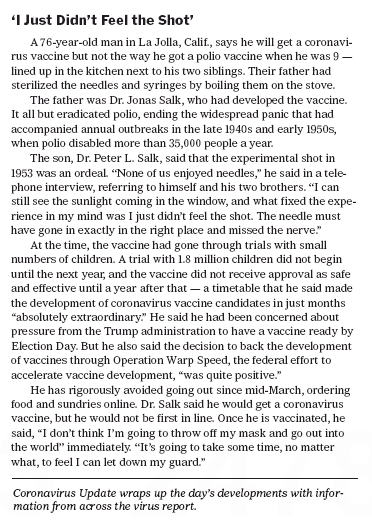(p. A1) GENEVA — On a cold weekend in mid-February [2020], when the world still harbored false hope that the new coronavirus could be contained, a World Health Organization team arrived in Beijing to study the outbreak and investigate a critical question: How did the virus jump from animals to humans?
At that point, there were only three confirmed deaths from Covid-19 outside China and scientists hoped that finding an animal source for the coronavirus would unlock clues about how to stop it, treat it and prevent similar outbreaks.
“If we don’t know the source then we’re equally vulnerable in the future to a similar outbreak,” Michael Ryan, the World Health Organization’s emergency director, had said that week in Geneva. “Understanding that source is a very important next step.”
What the team members did not know was that they would not be allowed to investigate the source at all. Despite Dr. Ryan’s pronouncements, and over the advice of its emergency committee, the organization’s leadership had quietly negotiated terms that sidelined its own experts. They would not question China’s initial response or even visit the live-animal market in the city of Wuhan where the outbreak seemed to have originated.
Nine months and more than 1.1 million deaths later, there is still no transparent, independent investigation into the source of the virus. Notoriously allergic to outside scrutiny, China has impeded the effort, while leaders of the (p. A8) World Health Organization, if privately frustrated, have largely ceded control, even as the Trump administration has fumed.
. . .
. . . , the health organization pushed misleading and contradictory information about the risk of spread from symptomless carriers. Its experts were slow to accept that the virus could be airborne. Top health officials encouraged travel as usual, advice that was based on politics and economics, not science.
The W.H.O.’s staunchest defenders note that, by the nature of its constitution, it is beholden to the countries that finance it. And it is hardly the only international body bending to China’s might. But even many of its supporters have been frustrated by the organization’s secrecy, its public praise for China and its quiet concessions. Those decisions have indirectly helped Beijing to whitewash its early failures in handling the outbreak.
. . .
China’s authoritarian leaders want to constrain the organization; President Trump, who formally withdrew the United States from the body in July, now seems intent on destroying it; and European leaders are scrambling to reform and empower it.
The search for the virus’s origins is a study in the compromises the W.H.O. has made.
. . .
The W.H.O. has repeatedly said that investigations are underway but has done little to clarify the uncertainty. Chinese health and diplomatic officials did not respond to repeated interview requests and have been publicly silent on what happened.
“This is part of the Chinese psyche — to demonstrate to the world that they do the very best science,” said Peter Daszak, a disease ecologist and president of EcoHealth Alliance in New York. “But in this case, it didn’t work. And I think that is the reason why we don’t know much more.”
. . .
. . . Dr. Tedros, . . . decided against declaring an international emergency after convening a committee to advise him.
What was not publicly known, though, was that the committee’s Jan. 23 decision followed intense lobbying, notably by China, according to diplomats and health officials. Committee members are international experts largely insulated from influence. But in Geneva, China’s ambassador made it clear that his country would view an emergency declaration as a vote of no confidence.
China also presented data to the committee, portraying a situation under relative control.
Half the committee said it was too early to declare an emergency. The outcome surprised many countries, as did Dr. Tedros when he publicly praised both Mr. Xi and China’s pneumonia surveillance system.
“It was that system that caught this event,” he said during a news conference.
That was wrong. China’s surveillance system had failed to spot the outbreak, a failure that experts now say allowed its spread to accelerate.
. . .
(p. A9) On the origins of the virus, the experts mostly shifted the onus to China, asking the government to prioritize a “rigorous investigation.” But they also assured people that numerous investigations were underway.
“It was an absolute whitewash,” said Lawrence O. Gostin, a professor of global health law at Georgetown University. “But the answer was, that was the best they could negotiate with Xi Jinping.”
. . .
In January, Dr. Tedros had announced that China had agreed to share biological samples. Nothing ever came of it.
Then the thesis about the origin of the outbreak suddenly pivoted.
Dr. Gao, the director of China’s C.D.C., told the journal Science in March that the virus may not have originated at the market. Maybe, he said, it “could be a place where the virus was amplified,” meaning it began elsewhere but spread wildly there.
Then Dr. Gao told a local TV station that animal samples from the market did not contain the virus. That indicated at least that samples had been taken from animals. Yet the details remained concealed.
(Note: the online version of the story has the date Nov. 2, 2020, and has the title “In Hunt for Virus Source, W.H.O. Let China Take Charge.”)


